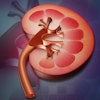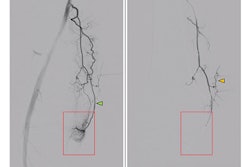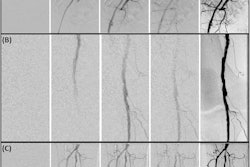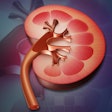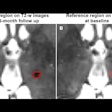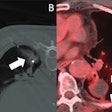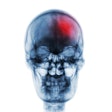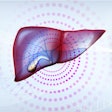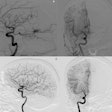Genicular artery embolization (GAE) has proven safe and effective in a sizeable, real-world group of patients with pain and disability due to knee osteoarthritis, according to research published July 22 in Radiology.
The study analyzed outcomes for 333 patients who underwent 444 GAE procedures and validates previous findings from smaller-scale studies, noted lead author Florian Fleckenstein, MD, of Charité - Universitätsmedizin Berlin, and colleagues.
“Further, the study is based on a cohort with a broad range of [knee osteoarthritis] severity, which markedly enhances the generalizability of GAE to everyday clinical practice, potentially broadening the applicability of this technique,” the group wrote.
Osteoarthritis affects approximately 500 million people worldwide, making it the third most rapidly growing cause of disability, the authors explained. In recent years, GAE has emerged as a minimally invasive treatment for knee osteoarthritis, with initial studies showing promising results. Yet current evidence is limited by small and carefully chosen patient cohorts, they added.
To further validate the procedure, the group gathered data on patients who underwent the procedure at their center between December 2022 and July 2024. Patients had Kellgren-Lawrence grades of 2, 3, and 4 (severe), and all experienced knee pain for more than six months despite undergoing intra-articular injections of corticosteroids, hyaluronic acid, or platelet-rich plasma.
The researchers assessed baseline-related symptoms using a numeric rating scale and the Knee Injury and Osteoarthritis Outcome Score (KOOS), a survey that measures overall knee health by evaluating stiffness, pain, function, and activities of daily living. Then they assessed outcomes at three weeks, three months, six months, and 12 months after GAE.
According to the results, patient-reported outcomes were available for 316 patients at six weeks, 282 at three months, 278 at six months, and 272 patients at 12 months. The median numeric rating scale decreased from seven at baseline to three at 12 months (p < 0.001). KOOS subscores showed improvement from baseline throughout the entire follow-up period, with the median KOOS subscore for quality of life improving from 19 to 42 after 12 months (p < 0.001).
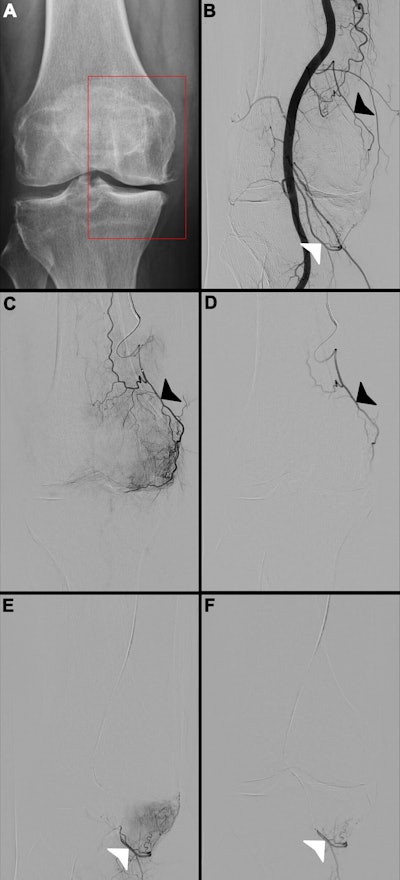 Images in a 65-year-old female patient. (A) Radiograph of the right knee shows Kellgren-Lawrence grade 3 knee osteoarthritis, with chronic pain localized to the medial compartment (red box). (B) Digital subtraction angiogram of the popliteal artery helps identify two potential target arteries: the superior medial genicular artery (black arrowhead) and the inferior medial genicular artery (white arrowhead). (C, E) Selective, pre-embolization digital subtraction angiograms of the superior medial genicular artery (black arrowhead in C) and the inferior medial genicular artery (white arrowhead in E) demonstrate a hyperemic blush in the medial compartment, indicative of pathologic hypervascularity. (D, F) Postembolization digital subtraction angiograms show successful stasis in the superior medial genicular artery (black arrowhead in D) and the inferior medial genicular artery (white arrowhead in F), with complete resolution of the hyperemic blush.RSNA
Images in a 65-year-old female patient. (A) Radiograph of the right knee shows Kellgren-Lawrence grade 3 knee osteoarthritis, with chronic pain localized to the medial compartment (red box). (B) Digital subtraction angiogram of the popliteal artery helps identify two potential target arteries: the superior medial genicular artery (black arrowhead) and the inferior medial genicular artery (white arrowhead). (C, E) Selective, pre-embolization digital subtraction angiograms of the superior medial genicular artery (black arrowhead in C) and the inferior medial genicular artery (white arrowhead in E) demonstrate a hyperemic blush in the medial compartment, indicative of pathologic hypervascularity. (D, F) Postembolization digital subtraction angiograms show successful stasis in the superior medial genicular artery (black arrowhead in D) and the inferior medial genicular artery (white arrowhead in F), with complete resolution of the hyperemic blush.RSNA
“The rapid onset of symptom relief, observed as early as 6 weeks after the procedure, along with sustained improvements over 12 months, emphasizes the long-term effect of the procedure,” the group wrote.
Additionally, improvements in the quality-of-life scores demonstrate not only pain reduction but also a positive impact of GAE on patients’ physical and psychological well-being, which are often substantially impaired in patients with chronic knee osteoarthritis, the researchers noted.
Ultimately, GAE may potentially delay the need for total knee arthroplasty, particularly in patients with moderate disease who are not yet candidates for surgery, as well as offer a valuable option for patients with advanced disease who cannot undergo surgery due to medical contraindications or who prefer to postpone or avoid surgery, they suggested.
“GAE may play a substantial role in the future management of knee osteoarthritis,” the researchers concluded.
The full study is available here.


